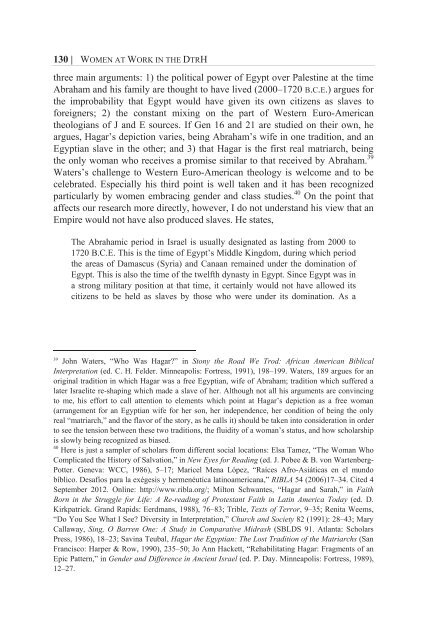Women at Work in the Deuteronomistic History - International Voices ...
Women at Work in the Deuteronomistic History - International Voices ...
Women at Work in the Deuteronomistic History - International Voices ...
Create successful ePaper yourself
Turn your PDF publications into a flip-book with our unique Google optimized e-Paper software.
130 | WOMEN AT WORK IN THE DTRH<br />
three ma<strong>in</strong> arguments: 1) <strong>the</strong> political power of Egypt over Palest<strong>in</strong>e <strong>at</strong> <strong>the</strong> time<br />
Abraham and his family are thought to have lived (2000–1720 B.C.E.) argues for<br />
<strong>the</strong> improbability th<strong>at</strong> Egypt would have given its own citizens as slaves to<br />
foreigners; 2) <strong>the</strong> constant mix<strong>in</strong>g on <strong>the</strong> part of Western Euro-American<br />
<strong>the</strong>ologians of J and E sources. If Gen 16 and 21 are studied on <strong>the</strong>ir own, he<br />
argues, Hagar’s depiction varies, be<strong>in</strong>g Abraham’s wife <strong>in</strong> one tradition, and an<br />
Egyptian slave <strong>in</strong> <strong>the</strong> o<strong>the</strong>r; and 3) th<strong>at</strong> Hagar is <strong>the</strong> first real m<strong>at</strong>riarch, be<strong>in</strong>g<br />
<strong>the</strong> only woman who receives a promise similar to th<strong>at</strong> received by Abraham. 39<br />
W<strong>at</strong>ers’s challenge to Western Euro-American <strong>the</strong>ology is welcome and to be<br />
celebr<strong>at</strong>ed. Especially his third po<strong>in</strong>t is well taken and it has been recognized<br />
particularly by women embrac<strong>in</strong>g gender and class studies. 40 On <strong>the</strong> po<strong>in</strong>t th<strong>at</strong><br />
affects our research more directly, however, I do not understand his view th<strong>at</strong> an<br />
Empire would not have also produced slaves. He st<strong>at</strong>es,<br />
The Abrahamic period <strong>in</strong> Israel is usually design<strong>at</strong>ed as last<strong>in</strong>g from 2000 to<br />
1720 B.C.E. This is <strong>the</strong> time of Egypt’s Middle K<strong>in</strong>gdom, dur<strong>in</strong>g which period<br />
<strong>the</strong> areas of Damascus (Syria) and Canaan rema<strong>in</strong>ed under <strong>the</strong> dom<strong>in</strong><strong>at</strong>ion of<br />
Egypt. This is also <strong>the</strong> time of <strong>the</strong> twelfth dynasty <strong>in</strong> Egypt. S<strong>in</strong>ce Egypt was <strong>in</strong><br />
a strong military position <strong>at</strong> th<strong>at</strong> time, it certa<strong>in</strong>ly would not have allowed its<br />
citizens to be held as slaves by those who were under its dom<strong>in</strong><strong>at</strong>ion. As a<br />
39 John W<strong>at</strong>ers, “Who Was Hagar?” <strong>in</strong> Stony <strong>the</strong> Road We Trod: African American Biblical<br />
Interpret<strong>at</strong>ion (ed. C. H. Felder. M<strong>in</strong>neapolis: Fortress, 1991), 198–199. W<strong>at</strong>ers, 189 argues for an<br />
orig<strong>in</strong>al tradition <strong>in</strong> which Hagar was a free Egyptian, wife of Abraham; tradition which suffered a<br />
l<strong>at</strong>er Israelite re-shap<strong>in</strong>g which made a slave of her. Although not all his arguments are conv<strong>in</strong>c<strong>in</strong>g<br />
to me, his effort to call <strong>at</strong>tention to elements which po<strong>in</strong>t <strong>at</strong> Hagar’s depiction as a free woman<br />
(arrangement for an Egyptian wife for her son, her <strong>in</strong>dependence, her condition of be<strong>in</strong>g <strong>the</strong> only<br />
real “m<strong>at</strong>riarch,” and <strong>the</strong> flavor of <strong>the</strong> story, as he calls it) should be taken <strong>in</strong>to consider<strong>at</strong>ion <strong>in</strong> order<br />
to see <strong>the</strong> tension between <strong>the</strong>se two traditions, <strong>the</strong> fluidity of a woman’s st<strong>at</strong>us, and how scholarship<br />
is slowly be<strong>in</strong>g recognized as biased.<br />
40 Here is just a sampler of scholars from different social loc<strong>at</strong>ions: Elsa Tamez, “The Woman Who<br />
Complic<strong>at</strong>ed <strong>the</strong> <strong>History</strong> of Salv<strong>at</strong>ion,” <strong>in</strong> New Eyes for Read<strong>in</strong>g (ed. J. Pobee & B. von Wartenberg-<br />
Potter. Geneva: WCC, 1986), 5–17; Maricel Mena López, “Raíces Afro-Asiáticas en el mundo<br />
bíblico. Desafíos para la exégesis y hermenéutica l<strong>at</strong><strong>in</strong>oamericana,” RIBLA 54 (2006)17–34. Cited 4<br />
September 2012. Onl<strong>in</strong>e: http://www.ribla.org/; Milton Schwantes, “Hagar and Sarah,” <strong>in</strong> Faith<br />
Born <strong>in</strong> <strong>the</strong> Struggle for Life: A Re-read<strong>in</strong>g of Protestant Faith <strong>in</strong> L<strong>at</strong><strong>in</strong> America Today (ed. D.<br />
Kirkp<strong>at</strong>rick. Grand Rapids: Eerdmans, 1988), 76–83; Trible, Texts of Terror, 9–35; Renita Weems,<br />
“Do You See Wh<strong>at</strong> I See? Diversity <strong>in</strong> Interpret<strong>at</strong>ion,” Church and Society 82 (1991): 28–43; Mary<br />
Callaway, S<strong>in</strong>g, O Barren One: A Study <strong>in</strong> Compar<strong>at</strong>ive Midrash (SBLDS 91. Atlanta: Scholars<br />
Press, 1986), 18–23; Sav<strong>in</strong>a Teubal, Hagar <strong>the</strong> Egyptian: The Lost Tradition of <strong>the</strong> M<strong>at</strong>riarchs (San<br />
Francisco: Harper & Row, 1990), 235–50; Jo Ann Hackett, “Rehabilit<strong>at</strong><strong>in</strong>g Hagar: Fragments of an<br />
Epic P<strong>at</strong>tern,” <strong>in</strong> Gender and Difference <strong>in</strong> Ancient Israel (ed. P. Day. M<strong>in</strong>neapolis: Fortress, 1989),<br />
12–27.




